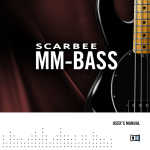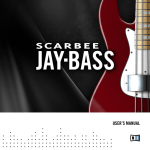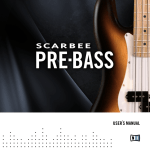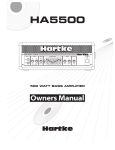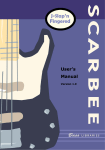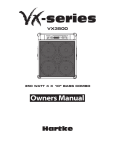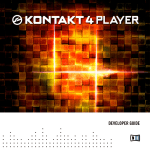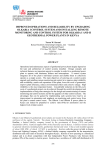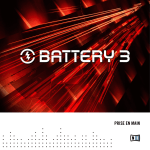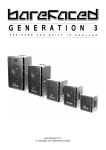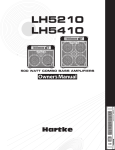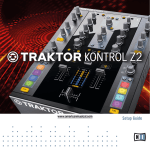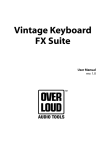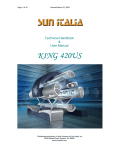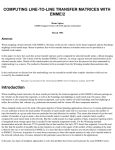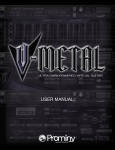Download Scarbee MM-Bass Amped Manual - AV
Transcript
USER’S MANUAL The information in this document is subject to change without notice and does not represent a commitment on the part of Native Instruments GmbH. The software described by this document is subject to a License Agreement and may not be copied to other media. No part of this publication may be copied, reproduced or otherwise transmitted or recorded, for any purpose, without prior written permission by Native Instruments GmbH, hereinafter referred to as Native Instruments. All product and company names are ™ or ® trademarks of their respective owners. Manual written by Nils Liberg, edited by Patryk Korman Document Version: 1.0 (08/2009) Product Version: 1.0 (08/2009) Special thanks to the Beta Test Team, who were invaluable not just in tracking down bugs, but in making this a better product. Germany Native Instruments GmbH Schlesische Str. 28 D-10997 Berlin Germany [email protected] www.native-instruments.de USA Native Instruments North America, Inc. 5631 Hollywood Boulevard Los Angeles, CA 90028 USA [email protected] www.native-instruments.com © Native Instruments GmbH, 2009. All rights reserved. Table Of Content 1 Foreword (by Nile Rodgers)................................................................................................6 2 Welcome to Scarbee MM-Bass - Amped!.............................................................................7 3 About Scarbee MM-Bass....................................................................................................8 3.1 About the Bass.............................................................................................10 3.2 Thomas Hansen Skarbye – The Bassist and Producer.........................................11 3.3 Nils Liberg – Script Developer.........................................................................12 4 Playing Bass Notes on a Keyboard.................................................................................... 14 4.1 Automatic String Selection............................................................................ 14 4.2 Manual String Selection.................................................................................15 5 Key Layout....................................................................................................................... 16 6 Articulations.................................................................................................................... 17 6.1 Sustains, Mutes and Harmonics......................................................................17 6.2 Hammer-on / Pull-off.....................................................................................17 6.3 Fast Grace Note Up.......................................................................................18 6.4 Slides..........................................................................................................18 6.5 Buzz-trills, Trills............................................................................................19 6.6 Trill Tails......................................................................................................19 6.7 Pickup Clap................................................................................................. 20 6.8 Automatically Triggered Samples.................................................................... 20 6.8.1 Release Samples............................................................................. 21 6.8.2 Pickup-hits..................................................................................... 22 7 Playing Techniques..........................................................................................................23 7.1 Index and Middle Finger Alternation................................................................ 23 7.2 Extended Hammer-on/Pull-off........................................................................ 24 7.3 Cross Hammering......................................................................................... 24 7.4 Chords........................................................................................................ 25 Scarbee MM-Bass - Amped – IV 7.5 Chord Slides................................................................................................ 26 7.6 Percussive Slides......................................................................................... 26 8 Sustaining Notes..............................................................................................................27 9 Vibrato............................................................................................................................28 10 Instrument Reset..............................................................................................................29 11 Main Menu and Instrument Settings..................................................................................30 11.1 Player Profile............................................................................................... 30 11.2 FX Presets.................................................................................................. 31 11.3 EQ............................................................................................................. 32 11.4 Vibrato........................................................................................................ 32 11.5 Pickup Hit................................................................................................... 33 11.6 Release ..................................................................................................... 34 11.7 Chords........................................................................................................ 35 11.8 Alternation.................................................................................................. 36 11.9 Noise Levels................................................................................................ 36 11.10 Controllers.................................................................................................. 37 11.11 Help........................................................................................................... 38 12 Differences Between Pre-Bass, MM-Bass - Amped, and Red Bass......................................39 13 Production Credits & Thank You’s.....................................................................................40 Scarbee MM-Bass - Amped – V 1 Foreword (by Nile Rodgers) When Thomas Hansen Skarbye first approached me about doing a bass sound dedicated to Bernard Edwards, naturally I was skeptical. Bernard’s sound is so distinctive and so elusive that it seemed an impossible task. The first time I heard Scarbee’s “MM-Bass”, I was stunned at how good it was, and how much it evokes the spirit and the sound of CHIC’s vibe. It was clear that Thomas’ passion and dedication to his craft, to the bass guitar, and to the legacy of Bernard Edwards was very profound, and that he had created something truly remarkable. We have recently been working on a number of projects that have 70’s and 80’s classic sounds. From a new Will Ferrell movie to some next generation music video games. MM-Bass software helps us to achieve a sound and feel so close to “classic”, that I expect we’ll be using it for many future projects. Nile Rodgers, founding member of Chic, world renowned producer, musician, guitarist, and songwriter about the MM-Bass D.I. Scarbee MM-Bass - Amped – 6 2 Welcome to Scarbee MM-Bass - Amped! Scarbee MM-Bass - Amped is a re-amped version of the original Scarbee MM-Bass instrument library. It was created to provide you with the particular sound of specific genres out of the box—without the need to employ bulky, expensive amps yourself. The library consists of four Scarbee MM-Bass instrument variations: •• Scarbee MM-Bass - Amped - Fat: a reamped version of the original MM-Bass, a round and tight bass sound specially produced for rock and pop oriented music productions. •• Scarbee MM-Bass - Amped - Heavy: a reamped version of the original MM-Bass, an edgy and hard bass sound specially produced for heavy rock oriented music productions. •• Scarbee MM-Bass - Amped - Crunchy: a reamped version of the original MM-Bass, a powerful and mildly distorted bass sound specially produced for rock oriented music productions. •• Scarbee MM-Bass - Amped - Pop: a reamped version of the original MM-Bass, a fat and crispy bass sound specially produced for R&B and pop oriented music productions. Scarbee MM-Bass - Amped – 7 3 About Scarbee MM-Bass The Scarbee MM-Bass was recorded with flatwound strings to get the warm and creamy sound of the 70s disco and funk bass lines, and D.I. to give maximum flexibility in the sound production. It features an extensive set of playing techniques, for example: •• Sustains •• Mutes •• Harmonics •• Hammer-on & pull-off •• Fast grace notes •• Slides (in most any speed you could want) •• Trills •• Buzz-trills •• Cross hammering •• Chords •• Chord slides •• Percussive slides •• Index and middle finger alternation •• Multiple sets of release samples: loose, tighter and tight. MM-Bass was designed to make it very easy to use all these while playing live. Except for the trills and cross hammering you can trigger all of the articulations and techniques above without the need for any key switches. The full strings of the bass have been sampled in order to reproduce the timbre changes that occur when you move between low and high frets on the string of a real bass. This results in a very rich sound with all the natural overtones. Scarbee MM-Bass - Amped – 8 It should be noted that MM-Bass is much more than just a collection of samples. It features a sophisticated script which takes care of many things automatically for you, for example: •• String selection •• A fretboard display updated dynamically as you play •• Alternation between index and middle finger •• Chord recognition1 •• Random alternation between three different types of release samples •• Random insertion of pickup hits2 Furthermore, the script enables you to configure all settings including EQ, load and store FX presets, and access documentation covering every aspect of the instrument directly through the instrument performance view. 1 Ensures correct string selection even if the chord notes don’t arrive at exactly the same time, and that the base note of a chord is played with index finger while the other notes are played with middle finger samples. 2 Not completely random because it is intelligent enough to take into account on which strings/frets and for which velocities pickup hits are most likely to occur. Scarbee MM-Bass - Amped – 9 3.1 About the Bass Since we have no special agreement with the company that manufactured the sampled bass we will not mention the trademarked name or show pictures of the bass. However, the instrument we used was an excellent and expensive american bass - an updated but classic sound. The truth is I didn’t use the exact same bass as we knew was on the beloved recordings from the 70s. I know exactly what bass was used on songs—and that the strings were totally worn-out roundwound strings, but when you deal with sounds your ears are more important than pure facts. The songs had sometimes been through more than one mastering session and the sound of the instruments changed for each mastering. Therefore the bass sound I was looking for was the one I heard out of the speakers—the processed sound. So by using an updated version of the original bass—which has a mellower tone as body is smaller, pickup magnets are Ceramic (original bass had Alnico magnets) and preamp different, and by using flatwound strings, I managed to get much closer to the sound I wanted and loved. Scarbee MM-Bass - Amped – 10 3.2 Thomas Hansen Skarbye – The Bassist and Producer When I was a boy, I wanted to be a great Magician, I wanted to amaze the audience and leave them wondering: “How did he do that?“ Years later, I am still very fond of “illusions“ in any media. I watch almost every movie that raises the bar of Special Effects and I share true interest in computer and console games with my sons for the same reason. These days my magic wand and top hat are the Scarbee Sample Libraries. I have played in various funk bands as a bassist during my younger years, but started soon to compose music for TV documentaries and aimed for a career as a film composer. After composing, producing music on more than 150 commercials for TV and Cinema (even working with Oscar winning director Bille August), I began to create Sample Libraries and Virtual Instruments as I wanted better sounds to use for my productions. These products are used by top artists around the world on albums and live. Due to “Carpal Tunnel Syndrome“ (weak wrists) I invented an artificial way of playing bass using software in 1998 and released the Scarbee J-Slap & J-Fingered in 2000. Originally planning a fretless bass release, I instead decided to take a break from the basses and do some “easy“ vintage keyboard sounds to use in my productions. Ironically it took me 5 years to complete the Vintage Keyboard Collection and the Vintage Keyboard FX plugin! Not exactly an easy job as I expected, but this is me in a nutshell; I go into something, dig deeper and deeper and slowly revealing the secrets and soul of the instrument and can not stop until the job is done. The MM-Bass project started in 2005 with the first sound recordings. Four versions was dumped before I finally found the right bass, strings and playing position. I wanted to find the sound that was closest to my identity as I had been searching all my life for the right sound— playing various bass brand in the world—with no luck. When listening to all my favorite bass Scarbee MM-Bass - Amped – 11 lines from the 70s, I soon realized that it was the same sound I came back to. It was a bass I never imagined I would own as it was too expensive when I was a young player and at that time I wasn’t that crazy about the fingered sound, more the slap sound. However, one evening I decided to put a set of flatwound strings on the bass to get a warmer, burning tone, and while experimenting with the right hand playing position I suddenly felt “it”: I instantly fell in love with the sound my fingers were producing—both the fingered and the slap sound—and I knew I had to create yet a piece of bass software, this time even better in any way. Personally I prefer to play hard on it to get the growl and aggressive tone, but it can also play gentle and soft. The amount of expression is the reason why this sound is one of my favorites. Scarbee MM-Bass is my personal tool, that I use in my work for other artists and in my own productions, so I will keep on updating it for the time to come, making extra details, slapped sounds etc. This will definitely benefit you as a user. Please enjoy our bass, we sure put a lot of love in it! I now give myself more time to compose and refine my vocal work as well, so please keep an eye on www.myspace.com/scarbee where I will post some of my songs. 3.3 Nils Liberg – Script Developer I was contacted by Thomas in the autumn of 2006 to create a Kontakt 2 script for what would later become MM-Bass. What initially seemed to be a small utility script for interval samples that I planned to implement in a day or two soon grew into something much bigger. Together we came up with ideas such as automatic string selection, easy ways to trigger grace notes and chord slides without keyswitches, and how to implement slides in all different tempi while keeping RAM usage down. Scarbee MM-Bass - Amped – 12 It was a very fruitful cooperation—me focusing on providing the user with the best possible interface in both musical and visual respects, and Thomas fully devoted to capturing the sound of not just the instrument but what it can sound like in the hands of a really good bass player. It has been a privilege to follow Thomas during this time—frustrating the times he decided to suddenly discard all the samples he’d recorded the week before because they didn’t live up to his high standards, but in the end a pleasure to work with someone with such a feeling for both detail and the bigger picture. My goal with the MM-Bass script has been to make the instrument so easy to play that the user will never feel it’s too much trouble to use any of the articulations. It feels doubly rewarding to have been able to put all my creativity into something that I know will finally be used as part of and benefit another person’s creative expression. It is my hope that you will find MM-Bass an inspiring instrument to use. Nils Liberg is an experienced script developer and is the author of a widely used script development environment for Mac/PC. Scarbee MM-Bass - Amped – 13 4 Playing Bass Notes on a Keyboard With stringed instruments a certain note can often be played on multiple strings, and so the player has to choose. For example, G2 can be played on all four strings of the bass with each string having its own very distinctive sound. Many sample libraries and virtual instruments take the simplistic route of recording only one sample per note (from the lower playing positions), which means that the user gets a very limited instrument. MM-Bass - Amped on the other hand includes samples of all the different strings each note can be played on, thus capturing the sound of the whole instrument. In our view the samples at higher frets is an integral part of the instrument and adds spice and variation to the sound. When a real bass player is about to play a note he/she typically chooses the string on which the note can be played with minimum effort. That is, without moving the left hand too much. On a keyboard it’s difficult to manually perform this string selection in real-time and laborious to do it after recording, so we came up with a way to let the MM-Bass - Amped script do it for you. 4.1 Automatic String Selection The figure below shows the main view of the instrument user interface. Note the white dotted line above the fretboard. It represents the position of the left hand on the bass neck—the playing position. When you play a note on the keyboard, MM-Bass - Amped automatically chooses a string that minimizes the need to move the playing position (the left hand), similar to a real bass player. This way you can get the full sound of the bass with minimum effort. I.e. if you play an octave interval, the correct strings will automatically be used. That’s the basic operation, but the automatic string selection also takes many other things into account such as when to use open strings and what special rules to use for each articulation. Scarbee MM-Bass - Amped – 14 Articulation specific symbols are displayed on the fretboard on the selected string/fret as shown above, and the text label below the fretboard shows the name of the last used articulation. Each string is monophonic so a new note interrupts any earlier one on the same string—just like on a real bass. Simply trying out MM-Bass - Amped oneself is perhaps the best way to understand how it works. 4.2 Manual String Selection It is also possible to control the string selection manually. Each string has an associated key switch: E0, A0, D0, G0—picked to be easy to remember. In MM-Bass - Amped a key switch affects the following note or remains active for as long as you hold it pressed. To return to the normal mode of operation just release the key switch. It is possible to combine more than one string key switch. For example you can hold A0 and D0 pressed simultaneously to make A and D be the preferred strings. Another way of controlling the string choice is by using key switches F5-B6 to specify which frets you prefer. The F5 key corresponds to the first fret, F#5 to the second fret and so on. To make it easier to learn we made the fret key switches match the corresponding note on the E-string of a bass (F is the first fret on this string, F# the second and so on). By pressing and releasing one of these key switches you move the playing position and at the same time trigger a fret noise sample (different noises are used depending on how far you move). You can also lock the playing position by holding one of these key switch pressed while playing. As will be shown later it is also possible to use a MIDI Controller for fret selection. Scarbee MM-Bass - Amped – 15 5 Key Layout Here is a schematic of the keys in MM-Bass - Amped. The red keys are key switches and the blue ones mapped to normal samples1. This is just an overview. Instructions on how to use each key switch and what it does is given in the following text sections. Keyswitches Normal bass Chord mode (D#0) Middle finger (C#0) Pickup hit and tight release toggle (F0) Index finger (F#0) Extended hammer-on/pull-off (F#0) Buzz-trill / Trill (G#0) Sustain (A-1) Mutes (A#-1) Reset (B-1) Playing Position Keyswitches (F5 TO B6 tret 1 to 20) Finger-picking Lead Pickup clap (A#0) A string (A0) B string (B0) C string (C0) D string (D0) Slap Fingered* *only Fingered is available at this point. The others represent possible future extensions 1 The bass has no B string, but for flexibility the notes B0 to D#1 have been mapped to a virtual B string. These notes use stretched E string samples. Only basic articulations like sustain, mutes, hammer-on and pull-off are available on the virtual B string. Scarbee MM-Bass - Amped – 16 6 Articulations 6.1 Sustains, Mutes and Harmonics Sustain is the default articulation. For velocities below 40 you get mutes instead, and for velocities below 15 you get harmonics where available and mutes otherwise. Enough velocities layers have been recorded to achieve natural transitions from soft to hard playing. Please note that harmonics are mapped to the string/fret where they are played on a real bass and not to the pitch of the sound. If you activate the mutes key switch (A#1) you will get mutes irrespectively of the velocity. This can be used to make it easier to trigger mutes since you do not need to rely on getting the right velocity when using it. 6.2 Hammer-on / Pull-off Legato To trigger a hammer-on or pull-off you simply play a half- or whole note either down or up legato (overlapping the earlier note). If a hammer-on or pull-off is not available (eg. when playing a note legato downwards from fret 1) you will get a sustain instead. Hammer-on / pull-off for intervals greater than 1-2 semitones may be played by activating the F#0 key switch. See more about this further down. Scarbee MM-Bass - Amped – 17 6.3 Fast Grace Note Up Fast Legato A fast grace note is triggered in the same way as a hammer-on, one needs to play the legato note very quickly after the previous note. Eg. play a C2, hold it pressed and press a D2 quickly after (between 20 and 60 milliseconds). The velocity of the lower note—the pre-hit note—is used as the velocity for playing the fast grace note sample. This allows you to play the second note at any velocity, which can help because one often ends up hitting it a bit harder since it has to be triggered so fast. It was an old dream since the year 2000 to be able to trigger fast grace notes in an intuitive way and now it has finally come true – no key switches are necessary! 6.4 Slides Legato + Slides are available in speeds 60 to 480 bpm. Play a note legato while holding the sustain pedal pressed to trigger a slide. If it’s not possible to slide the played interval without going outside of the available frets a sustain will be used instead. The velocity of the target note determines the speed of the slide. There are three recorded slide tempi: Velocities 1-30 trigger the slowest slide sample (60 to 89 bpm) Velocities 31-60 trigger the middle slide sample (90 to 119 bpm) Velocities 61-127 trigger the fastest slide sample (120 to 480 bpm) The beats per minute (bpm) tempo numbers above refer to the duration of a 1/4 note in that tempo. To play a 1/8 note slide in tempo 120 you need to use a slide note velocity which corresponds to 240 bpm, and to play a 1/16 note slide (very fast) in tempo 120 you will need a velocity which corresponds to 480 bpm. Scarbee MM-Bass - Amped – 18 6.5 Buzz-trills, Trills A buzz-trill is the sound of a real bass player moving his finger back and forth over a fret quickly. A trill on the other hand is a sequence of repeated hammer-on and pull-offs. Buzz-trills and trills are activated by pressing the G#0 key switch. Buzz-trills are available on the D and G string and trills on the G string. •• Velocities 1-59 give trills on G string and long buzz-trills on D string. •• Velocities 60-89 give long buzz-trills •• Velocities 90-127 give short buzz-trills Note that unlike the other key switches G#0 only affects the following note even if it were to be held pressed. We made it like this to make it easier to trigger a single trill without accidentally affecting other notes. 6.6 Trill Tails Trill tails are based on the same samples as trills except that their attack has been removed in order to make it possible to use them after any other articulation—as a tail. They are available on the G string. + Legato (down) To trigger a trill tail press the G#0 key switch to activate trill mode and then play a pull-off (a half or whole note legato down). Please note that the key switch must be pressed just before the pull-off note and not earlier or you will get a trill or buzz-trill instead of a sustain on the preceding note. Here’s an example of how a trill tail can be performed: play A3 and hold it pressed, play the G#0 key switch, play a legato down to G3. The G3 legato note is played back as a trill tail. Scarbee MM-Bass - Amped – 19 6.7 Pickup Clap Play A#0 to get the sound of a pickup clap. Please note that A#0 behaves more like a normal note than a key switch—the A#0 itself triggers the sound and it does not affect other notes. As many as 27 different pickup clap samples are included. A real bass player typically hits the pick-up with his/her right hand on snare drum hits (2/4) to keep the beat—or as some advanced players: hit the pick‑up as a flaminco guitarist in between notes for a funky, unique bass groove. 6.8 Automatically Triggered Samples Included in MM-Bass - Amped are a number of samples which are automatically played back at certain times. In the settings you can configure what types of samples you want to use and how often you want them to be played. Detailed explanations of how to make these settings can be found later in this manual. Scarbee MM-Bass - Amped – 20 6.8.1 Release Samples A release sample is played whenever a note is released. With one exception: when a note is played legato (overlapping the earlier note) a release sample is not played for the earlier note. There are three sets of release samples: •• loose •• tight 1 •• tight 2 The loose samples are noisier and adds character to the sound. Tight 1 is a more tightly played type of release which is less prominent and cleaner. And finally, tight 2 is similar to tight 1 but even more cleanly played and is the least noisy of them all. In the settings you can setup how often you want to hear each one of the types. ▲ Toggles loose/tight So which type should one use then? Well, it depends on the style and what kind of bass player one wants to imitate. The professional and often hired studio musicians usually have a very fine dampening technique—so you rarely hear the releases—even when they are playing fast. These bass players, who you hear on so many albums, mute the strings with a combination of the left and and right hand to avoid ringing and other noise from the bass. However, even they sometimes decide to play a bit more relaxed and then you will hear more of the release sound. In more rock oriented songs you will play much more relaxed and even appreciate the raw sound of loose dampening. In the settings you can specify whether you want all three types of release or just the tight ones by default. The F0 key switch can then be used to switch from the default mode to the non-default mode. Scarbee MM-Bass - Amped – 21 6.8.2 Pickup-hits ▲ Toggles loose/tight MM-Bass - Amped includes as many as 43 different pick-up hit noises. These samples simulate a bass player playing the strings hard by banging his/her hand on them–giving a slight pickuphit noise. During the normal course of playing a pickup-hit noise sample is sometimes randomly played together with the note you played. In the settings you can configure what the chance should be for this to happen and whether it should be active by default. Having some pickup-hit noises now and then can, just like loose release samples, add to the realism. Furthermore, since both release samples and pickup-hit noises are randomly selected they add extra variation. The human ear is very good at hearing when a sound is repeated so this is an important feature. Scarbee MM-Bass - Amped – 22 7 Playing Techniques 7.1 Index and Middle Finger Alternation Separate sample sets for right hand index finger and middle finger playing has been recorded for many articulations1. The alternation between these two is performed automatically. When you play slowly, you only get index samples, and when you play faster, MMBass - Amped alternates between index and middle finger samples as a real bass player would. You can configure the speed threshold for when alternation is to start (see Alternation in the settings). The alternation can also be controlled manually by using key switch C0 to activate index finger and C#0 to activate middle finger samples. Like the other key switches these affect the following note or remain active for as long as they are held pressed. Pressing any of these key switches will inhibit the automatic alternation. Scarbee MM-Bass - Amped – 23 7.2 Extended Hammer-on/Pull-off Normally hammer-on and pull-off are triggered by playing an interval of one or two notes up or down legato with the previously held note. However, it is possible to use the same articulations for larger intervals. To do this, activate Extended Hammer-on / Pull-off mode by pressing the F#0 key switch. + Legato For example if you play A1, hold it pressed and then play E2 while holding the F#0 key switch pressed the E2 will be played as a whole-note hammer-on on the same string as the A1 even though the interval is a fifth. Please note that the extended mode affects the automatic string selection—the script will try to stay on the same string even if the target note is not near the current playing position. The articulations with two alternations are sustains, mutes, harmonics, fast grace notes and release samples. % 7.3 Cross Hammering + You can get cross hammering by combining a string key switch with the extended hammer-on/pull-off mode described above. When this key switch combination is activated you no longer have to play legato to trigger a hammer-on. Instead, any note will trigger a whole-note hammer-on. Let’s say you want to cross hammer E2 on the A string. In order to do this, hold the E0 and F#0 key switches pressed (E string + extended mode), and then play E2 on the keyboard. Scarbee MM-Bass - Amped – 24 7.4 Chords Normally chords work well in the default mode. However, in some special cases the automatic string selection can fail since the script cannot see into the future. The notes of a chord never arrive at exactly the same time but typically some milliseconds after each other, and in a more or less random order. The string selection is usually performed one note at a time, but in unfortunate situations the optimal string for the chord note which comes first can be a suboptimal choice for the chord as a whole—it might be even better to use that string for a chord note which arrives just milliseconds later. To solve this problem we provide a chord mode which is activated by key switch D#0. When the chord mode is active the scripts waits for all the notes in the chord to arrive before it decides on what strings to use. Only then is playback started. The longer the script is allowed to wait for new notes in a chord the sloppier a user can play them and still have them recognized as a chord. But the longer the script waits the longer will also the playback of the notes be delayed. So there is a trade-off between allowing for sloppily played chords and latency. In fact the script waits for extra notes in the same way even when chord mode is not active, but then a much shorter waiting time is used (the default is 0.5 ms)—so short that one cannot hear it. It is not possible for a human to play chords that tightly, but if you align notes in your sequencer and make the first and last note be close enough that will make it possible for the chord to be recognized. Hence, for live playing you can use D#0 to activate chord mode, but if you choose to align notes after recording you don’t have to use the key switch. It’s up to you as the user. Scarbee MM-Bass - Amped – 25 In addition to proper string selection, another advantage of having a played chord recognized as a unit as opposed to a series of individual notes is that the lowest chord note is automatically played using index finger samples and higher notes using middle finger samples, just like one would play it in real life. 7.5 Chord Slides Playing a whole chord legato with an earlier chord would be difficult, so instead we came up with a single finger technique to make it easier to perform chord slides. In order to play a chord slide first play the chord. Then press the sustain pedal and play the target note to which you want to slide (just as before the velocity of this note determines the slide speed). The MM-Bass - Amped script will determine the interval between the target note and the note in your chord that is closest to the target note. This interval is then used as the slide interval. For example: let’s say you play the chord G1-D2-G2. To slide up a whole note you can press A2 while holding the sustain pedal pressed. The chord note nearest A2 is G2 and the interval is a whole note up which is then used as the slide interval. As an alternative to A2 it would also be possible to use A1 (a whole note up from the chord base note) or E2 (a whole note up from the middle chord note). To slide up one octave you would play G3 (one octave up from the nearest note, G2). Note that a chord slide will only be performed when it is possible to slide the interval for all notes in the chord. 7.6 Percussive Slides It’s possible to perform percussive slides by playing extra notes on the same string a note is being slided on at the same time as the slide is being performed. Scarbee MM-Bass - Amped – 26 8 Sustaining Notes Since the sustain pedal is already used to trigger slides another way of sustaining notes is needed. This is what the A-1 note is used for: while it is held pressed any released note will be prolonged until the A-1 note is released. So this key works just like the pedal does for other instruments. It is sometimes useful to be able to sustain repeated notes in order to get rid of the disconnected feeling that gaps between the notes can give. Try for example to play E1, E1, E1, ... without holding A-1 pressed and then with A-1 pressed. However, please note that by sustaining notes there will be no time to play the release sample of one note before the next starts, and without the release samples one looses some of the important variation that increases realism. So it’s important not to overuse this feature. You can in many cases get better results if you don’t use A-1 and instead adjust note lengths in your sequencer (making one note end just slightly before the next one starts). You may also configure a MIDI CC to use for this purpose instead of the A-1 key (see the Controller settings below). Scarbee MM-Bass - Amped – 27 9 Vibrato The vibrato characteristics of a real bass was analysed and the results incorporated into MMBass - Amped. MM-Bass - Amped is also capable of mimicing the slight fret noise generated by the finger movements used to create the vibrato. Vibrato intensity is controlled by the modulation wheel (CC#1). If you select the Vibrato page from the main menu you can configure the vibrato speed, vibrato fret noise volume, and specify whether you want to use CC#1 or Aftertouch to control the intensity. See Vibrato settings below. Scarbee MM-Bass - Amped – 28 10 Instrument Reset MM-Bass - Amped randomly chooses between different types of release samples, fret noises and when to insert pickup-hits. This randomness gives more variation and a more realistic sound. However, it is also good to be able to predict the behavior to know that your song will sound exactly the same each time you play it. This is possible by using the B-1 key switch to reset the instrument. In order to get the same result each time you play back your song insert a B-1 key switch note in the beginning of the song. The velocity with which this key switch is played determines the random sequence of values which controls release samples, fret noises and timing of pickup-hits. You can use any velocity, but please note that if you change the velocity of this initial B-1 key switch note you will get a completely different sequence of release samples, fret noises and pickup-hits. Scarbee MM-Bass - Amped – 29 11 Main Menu and Instrument Settings 11.1Player Profile Here you can specify what type of playing style you want to use. This affects the automatic string selection and whether high or low frets are preferred. For example, when playing rock a bass player would typically not use the lowest fret numbers. •• Pop & Country - no specific preference for low/high frets •• Soul & Funk - frets above fret 4 are preferred •• Rock & Retro - frets above fret 6 are preferred Even with the latter settings it is still possible to use lower frets if you tell the instrument to do so by activating string or playing position key switches. Scarbee MM-Bass - Amped – 30 11.2FX Presets The instrument comes with a number of factory presets which can be loaded by simply selecting them from the preset menu (see image). Be aware that whenever you load an effect preset any customization of the MM-Bass - Amped insert effect parameters you might have done can be overwritten. You can also save your own presets. To do this edit the insert effects parameters in KONTAKT to your liking and then choose one of the Save... menu items from the preset menu. Please note that due to a KONTAKT 2/3 limitation, scripts cannot load new effects but only change parameters of already loaded ones. This has been worked around by loading all kinds of effects and bypassing the ones which are not necessary. The status of the bypass buttons is stored in each preset and restored when one is loaded. Presets are stored within the KONTAKT instrument file (.nki file) so in case you later download an update to MM-Bass - Amped that file will lack any customized presets of yours, which is useful to be aware of. However, you can transfer a preset from one instrument to another by using the native preset feature in KONTAKT and then choose Save... from the menu to reintegrate it into the script preset system. Scarbee MM-Bass - Amped – 31 11.3EQ In this section the Bass, Middle and Treble can be adjusted. Beware that loading an FX preset can change the EQ. 11.4Vibrato Here you can specify the vibrato speed and the volume of the fret noises that are automatically generated in order to mimic the noises generated as the finger move back and forth on a string. You can also decide whether to use CC#1 or Aftertouch to control the vibrato intensity. Scarbee MM-Bass - Amped – 32 11.5Pickup Hit For every note you play the script decides whether a pickup-hit noise should be played or not. Here you can set the chance for it to happen. At 0% you never get a pickup hit and at 100% you always get it. The default mode determines whether pickup-hit noises should be enabled by default. It can be either of: •• Pickup hits: noises are ON by default. Hold the F0 key switch to turn them off. •• No pickup hits: noises are OFF by default. Hold the F0 key switch to turn them on. Please note that the default release mode and pickup are coupled, i.e. if you select “Pickup hits” as your default mode the release mode will be set to Random. When you load MM-Bass - Amped the pickup hit knob is set to 0%, so if you want pickup hits you need to increase it. It can also be automated using CC#4 (or some other controller of your choice). Scarbee MM-Bass - Amped – 33 11.6Release The Decay knob in the upper right corner controls how much more silent a release sample becomes for each second longer you hold a note pressed. The unit is dB / second. I.e. if it is set to 15 dB/s then the volume of a release sample of a 2s long note will be turned down 30 dB. There are three types of release samples: loose, tight 1 (quite tight) and tight 2 (very tight). The tight samples are played more carefully and are less noisy than the loose ones. You can set the default release mode to be one of: •• Random mode – use random mix of loose, tight 1 and tight 2 samples •• Tight mode – use random mix of tight 1 and tight 1 samples only By using the F0 key switch you can switch to the non-default mode at any time. Eg. let’s say the default mode is set to Random mode. Then you will sometimes get loose release samples when playing. If you want only tight release samples for some passage of a song you can hold F0 pressed during that time to temporarily toggle to Tight mode. The loose / tight knob controls the probability of getting either loose or tight release samples. Turn it up to increase the chance of getting tight samples. The tight 1 / tight 2 knob controls the probability of getting tight 1 versus tight 2 samples. Turn it up to increase the chance of getting tight 2 samples. Scarbee MM-Bass - Amped – 34 11.7Chords The illustration below shows how the notes of a chord never arrive at exactly the same time – there is always a period of time between the first and last last note. As long as this period of time is shorter in milliseconds than the Sloppiness knob value shown to the right, the chord will be properly recognized and automatic string selection will work optimally. If on the other hand the period of time between notes gets longer than the Sloppiness value the automatic string selection is performed note by note which in some cases can yield suboptimal results for chords. By increasing the sloppiness the tolerance for sloppily played chords increases, but at the same time the latency is increased by the same amount leading to a less responsive instrument. For this reason it is preferable to use a high sloppiness setting only when one is about to play chords and a low value otherwise in order to minimum latency. When chord mode has been activated by the D#0 key switch the left sloppiness setting is used. And when chord mode is not active the normal sloppiness setting to the right is used. In other words, D#0 temporarily activates a higher latency which makes the string selection for chords more reliant and as soon as the key switch is released the low latency is restored again. Scarbee MM-Bass - Amped – 35 11.8Alternation When you play notes quickly after each other automatic alternation between index and middle finger samples takes place. When you play slower only index finger samples are used. You can specify the threshold for what the script should consider fast playing by setting the Alt. Time knob. When you play a note there will be automatic alternation only if the period of time since the last note is lower than this. With the default setting automatic alternation starts when notes are played at shorter time intervals than 1 second. 11.9Noise Levels Here you can adjust the volume of the various noise samples: •• Release samples Scarbee MM-Bass - Amped – 36 •• Fret noise •• Pickup-hits, and •• Pickup clap 11.10 Controllers In addition to key switches it is also possible to control some parameters using MIDI Controllers: Playing position: an alternative to the F4-B5 key switches. When it is set you can use that controller to move the playing position. Unlike the key switches this will not trigger fret noises and one cannot lock the playing position this way since there is no analogue to holding a key pressed. Slide mode: by default CC#64 (sustain pedal) is used to activate slide mode, but here you can specify another controller to be used if desired. Release: the CC used to control the balance between Loose and Tight release samples, i.e. the Loose/Tight knob on the Release settings page. Sustain: a CC number used to sustain notes (like a sustain pedal sustains notes). Please take care not to overuse this feature since some space between notes can be good in order to get a realistic release sound. Pickup hit chance: you can here configure a controller with which to automate the Pickup hit ratio knob (see the Pickup hit settings above). Scarbee MM-Bass - Amped – 37 11.11 Help For quick reference you can find documentation for articulations & playing techniques, settings and the script UI directly in the performance view. Select a help topic from the menu and a help text appears to the left. Scarbee MM-Bass - Amped – 38 12 Differences Between Pre-Bass, MM-Bass Amped, and Red Bass Pre-Bass MM-Bass - Amped Red Bass Pick-up mics split single-coil pickup (1) humbucker (1) bridge, both and neck (3) Buzz-trills short and long short and long short Release loose, tight 1 and tight 2 loose, tight 1 and tight 2 loose and tight Pickup hit noise automatic or manual automatic or manual manual Slide up available on all frets on all frets on fret 0-9 Slide down available on all frets on all frets on fret 4-21 Slide up range full string 1 octave 1 octave Slide down range full string 1 octave full string legato playing with sustain pedal pressed legato playing with sustain pedal pressed, but for slide intervals greater than two semitones the slide has to be manually ended by playing the target note a second time Slide triggering legato playing with sustain pedal pressed Index / middle available available available, but middle finger samples have a shorter duration than index finger samples. Number of samples 3 766 4 003 6 092 Size 2.9 GB 3 GB 2 GB Size of download (compressed) 1.2 GB 1.2 GB 747 MB Scarbee MM-Bass - Amped – 39 13 Production Credits & Thank You’s Producer, Bass Player & Programmer Thomas Hansen Skarbye Script Developer & User Manual Nils Liberg Instrument Graphics Stefan Kengen Beta Testers Richard Hilton, Jules Bromley and Stefan Kengen Thank You’s My wife Anne, for all your work, support, and love. To Nils Liberg, you have been fantastic and one of the finest and brightest persons I have ever met, you should be proud of yourself! To Richard Hilton and Nile Rodgers for their support and friendship, Native Instruments for their powerful Kontakt 2.2.3 engine, Philip Pendleton for his help with web matters, Klaus Simone for his help in healing my soul, Jules Bromley for his beta feedback and Stefan Kengen for the MM-Bass instrument graphics, it looks so cool. To Jimmy Østbygaard from Futureware for fast help, Sound Soap, the great friends from Gaya Musik: Kim, Steffen and Victor. Big thanks to Garth Hjelte from Chickensys; could not have done it without Translator. To all Scarbee users: Thanks for your support. Finally to my sons Nikolaj, Oscar and Victor, I love you so much. MM-Bass is dedicated to Bernard Edwards (1952-1996) Copyright Disclaimer All product and company names, brands and logos mentioned in this document are exclusive property of the respective owners. Some product names, descriptions and images are cited for the sole purpose of identifying the specific products that we used to develop Scarbee MM-Bass - Amped. Scarbee is in no way related to or affiliated to any of the mentioned companies. © 2009 SCARBEE. All rights reserved. Scarbee MM-Bass - Amped – 40








































